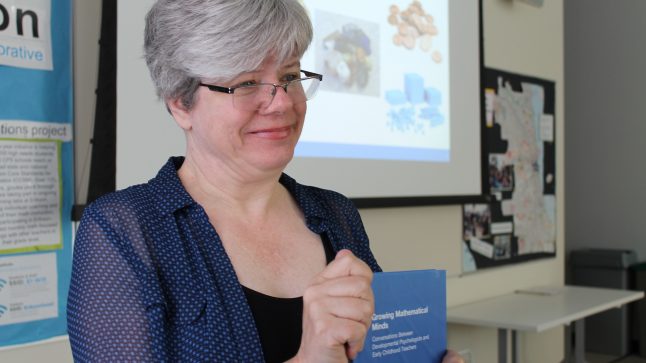2nd Grade Math
Series: Focus on Collaboration
School Event Engages Families in Early Math Learning
June 19, 2019
Families play a fundamental role in shaping children's interest and skills in math. Schools can help connect the math that exists both in and out of school and nurture families' positive relationship to math.
- Age/Grade Level: Infants, Toddlers, Pre-K, Kindergarten, 1st Grade, 2nd Grade, 3rd Grade
- Tags Family Math, Games
Series: Ideas at Work June 8, 2019
Build Tangram Shapes with Do-It-Yourself Puzzles
A tangram puzzle consists of seven pieces — five triangles and two quadrilaterals made from one square. Tangrams originated in China hundreds of years ago. They traveled to Europe in the 1800’s, where they gained…
- Topic: Spatial Relationships, Shape
- Age/Grade Level: Pre-K, Kindergarten, 1st Grade, 2nd Grade
- Tags Play, Family Math, Grandfather Tang's Story, Ann Tompert
Series: Focus on the Child December 8, 2018
Counting a Large Collection with Child 14
A second grader has a partial understanding of counting in equal groups, but is still working on rational counting. Focus on the Child videos are taken from one-on-one interviews with individual children. The interviews are…
Series: Focus on the Child November 17, 2018
Subtraction as the Inverse of Addition with Child 5
This second grader uses a known number combination (3 + 9) to solve a subtraction problem, showing an understanding of how addition and subtraction are related as inverse operations.
- Topic: Number Operations
- Age/Grade Level: 1st Grade, 2nd Grade, 3rd Grade
- Tags Child 5
Series: Hear from the Experts October 24, 2018
Measuring Math Understanding of ELLs with Barbara Sarnecka and David Purpura
A panel of early math experts engage with the audience at Promising Math 2017 to consider the challenges of getting a true picture of what young children understand about numbers.
- Age/Grade Level: Adult Learners, 1st Grade, 2nd Grade, 3rd Grade
- Tags Promising Math
Series: Book Ideas October 22, 2018
A Holiday with Too Many Tamales
How is it possible to have too many tamales? Well, Maria finds out in the holiday storybook Too Many Tamales by author Gary Soto.
- Topic: Number Operations
- Age/Grade Level: Pre-K, Kindergarten, 1st Grade, 2nd Grade, 3rd Grade
- Tags Too Many Tamales, Family Math, Gary Soto, Books, Holiday, Food, Seasonal
Series: About the Collaborative October 3, 2018
New Book Connects Early Math Teaching with Developmental Research
A new book released in August 2018 from the Collaborative examines the connections and questions that arise from discussing math experiences in early childhood settings and the research into children's mathematical learning.
- Age/Grade Level: Pre-K, Kindergarten, 1st Grade, 2nd Grade, 3rd Grade
Series: Book Ideas September 11, 2018
3 "Mathical" Books for More Advanced Counting
Along with being "mathical" award winners, these books provide compelling contexts that help primary grade children understand why more advanced counting is useful and that it isn’t always efficient to count by ones.
- Topic: Counting
- Age/Grade Level: Kindergarten, 1st Grade, 2nd Grade, 3rd Grade
- Tags Sheep Won’t Sleep, Judy Cox, Max’s Math, Kate Banks, One Big Pair of Underwear, Laura Gehl
Series: Hear from the Experts June 22, 2018
Instructional Tools to Integrate Language and Math Concepts with Halla Jmourko
Halla Jmourko discusses two innovative instructional tools for integrating language and math concepts in the classroom, The Cubing Game and Three Way Tie.
- Age/Grade Level: Adult Learners, Kindergarten, 1st Grade, 2nd Grade, 3rd Grade
- Tags Games, Promising Math
Series: Ideas at Work January 29, 2018
Exploring the Three-Reads Math Protocol for Word Problems
Teachers in four schools recently experimented with a "problem stem" protocol for helping their children understand the math going on in the word problems they face in class. This was part of our Big Shoulders…
- Age/Grade Level: Pre-K, Kindergarten, 1st Grade, 2nd Grade, 3rd Grade
Do the math.
Free videos.
Free newsletter packed with ideas.
Free professional learning modules.









